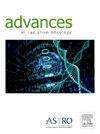Long-Term Toxicity after Non-Myeloablative Conditioning Regimens Using Total Body Irradiation
IF 2.7
Q3 ONCOLOGY
引用次数: 0
Abstract
Purpose
To evaluate long-term health risks after allogeneic hematopoietic stem cell transplantation (HSCT) using non-myeloablative total body irradiation (TBI).
Methods and Materials
All adult patients undergoing non-myeloablative allogeneic HSCT using TBI-based conditioning from 1995 to 2020 at our institution were included. Long-term toxicities, defined as events persisting beyond or occurring after 6 months from the date of transplant, were graded per the National Cancer Institute's Common Terminology Criteria for Adverse Events version 5.0. A competing risk analysis was performed to assess the risk of developing long-term toxicities within major organ systems using the Fine-Gray model. Outcomes were compared with a cohort of patients undergoing myeloablative TBI.
Results
A total of 174 patients undergoing nonmyeloablative HSCT were assessed along with 378 myeloablative patients. Nonmyeloablative recipients were older (58 vs 43 years, P < .001), less likely to be transplanted for acute leukemia (35% vs 64%, P < .001), more likely to be transplanted for non-malignant conditions (33% vs 11%, P < .001), and were more likely to have used tobacco (33% vs 22%, P = .009). The median follow-up was 7.4 years. The cumulative incidences of long-term toxicities at 5 years for nonmyeloablative and myeloablative patients, taking into account the competing risk of death, were pulmonary (4% vs 4.8%, P > .9), cardiac (6.8% vs 3.3%, P = .11), renal (4.3% vs 4.1%, P = .9), thyroid (3.6% vs 1.5%, P = .2), other endocrine (3.1% vs 8.8%, P = .04), and cataracts (2.5% vs 2.8%, P = .7). The risk of developing a secondary malignancy was 3.5% vs 1.1% (P = .2) between the 2 cohorts. The proportion of all toxicities that were high-grade (3-5) for nonmyeloablative and myeloablative regimens, respectively, were pulmonary (60% and 69%), cardiac (17% and 45%), renal (27% and 21%), and other endocrine (4% and 2%).
Conclusions
Recipients of nonmyeloablative conditioning regimens, despite receiving much lower doses of TBI and chemotherapy, are at risk of developing significant, long-term medical conditions comparable with those undergoing myeloablative HSCT.
使用全身照射的非清髓调理方案后的长期毒性
目的评价非清髓性全身照射(TBI)对同种异体造血干细胞移植(HSCT)术后的长期健康风险。方法和材料纳入1995年至2020年在我院接受非清髓性同种异体造血干细胞移植的所有成人患者。长期毒性,定义为从移植之日起6个月后持续或发生的事件,根据美国国家癌症研究所不良事件通用术语标准5.0版进行分级。使用Fine-Gray模型进行了竞争性风险分析,以评估主要器官系统内发生长期毒性的风险。结果与一组接受清髓性脑损伤的患者进行比较。结果174例非清髓性HSCT患者和378例清髓性HSCT患者接受了评估。非清髓受体年龄较大(58岁vs 43岁,P <;.001),急性白血病移植的可能性较低(35% vs 64%, P <;.001),非恶性情况更有可能被移植(33% vs 11%, P <;.001),并且更有可能使用烟草(33% vs 22%, P = .009)。中位随访时间为7.4年。考虑到竞争死亡风险,非清髓和清髓患者5年长期毒性累积发生率为肺(4% vs 4.8%, P >;.9)、心脏(6.8% vs 3.3%, P = .11)、肾脏(4.3% vs 4.1%, P = .9)、甲状腺(3.6% vs 1.5%, P = .2)、其他内分泌(3.1% vs 8.8%, P = .04)和白内障(2.5% vs 2.8%, P = .7)。两组患者发生继发性恶性肿瘤的风险分别为3.5%和1.1% (P = 0.2)。非清髓方案和清髓方案的所有毒性中,高级别(3-5)的比例分别为肺(60%和69%)、心脏(17%和45%)、肾脏(27%和21%)和其他内分泌(4%和2%)。结论:非清髓性调节方案的受者,尽管接受了低剂量的TBI和化疗,但与接受清髓性造血干细胞移植的患者相比,仍有发生重大、长期疾病的风险。
本文章由计算机程序翻译,如有差异,请以英文原文为准。
求助全文
约1分钟内获得全文
求助全文
来源期刊

Advances in Radiation Oncology
Medicine-Radiology, Nuclear Medicine and Imaging
CiteScore
4.60
自引率
4.30%
发文量
208
审稿时长
98 days
期刊介绍:
The purpose of Advances is to provide information for clinicians who use radiation therapy by publishing: Clinical trial reports and reanalyses. Basic science original reports. Manuscripts examining health services research, comparative and cost effectiveness research, and systematic reviews. Case reports documenting unusual problems and solutions. High quality multi and single institutional series, as well as other novel retrospective hypothesis generating series. Timely critical reviews on important topics in radiation oncology, such as side effects. Articles reporting the natural history of disease and patterns of failure, particularly as they relate to treatment volume delineation. Articles on safety and quality in radiation therapy. Essays on clinical experience. Articles on practice transformation in radiation oncology, in particular: Aspects of health policy that may impact the future practice of radiation oncology. How information technology, such as data analytics and systems innovations, will change radiation oncology practice. Articles on imaging as they relate to radiation therapy treatment.
 求助内容:
求助内容: 应助结果提醒方式:
应助结果提醒方式:


